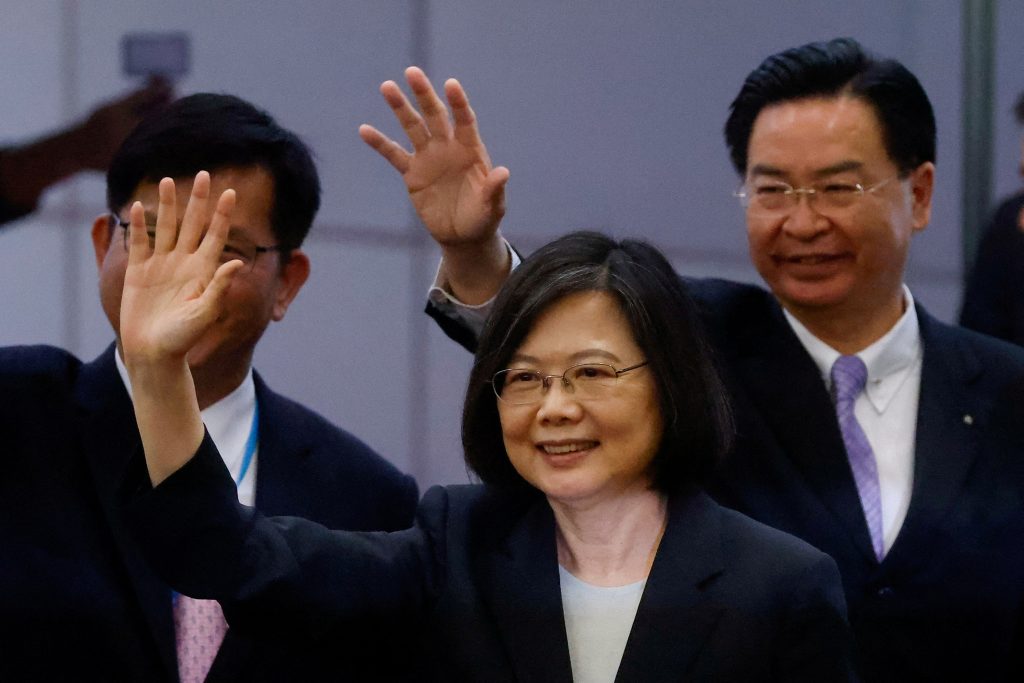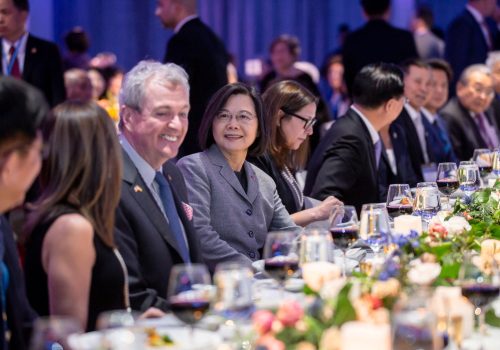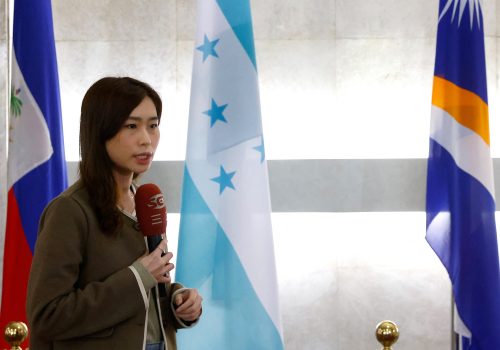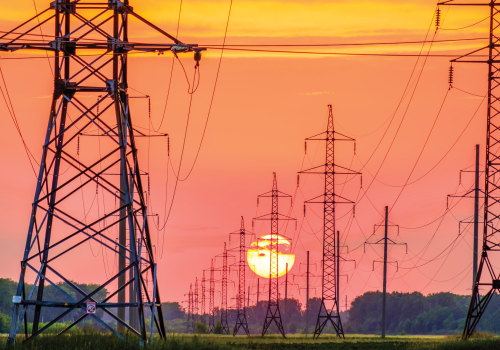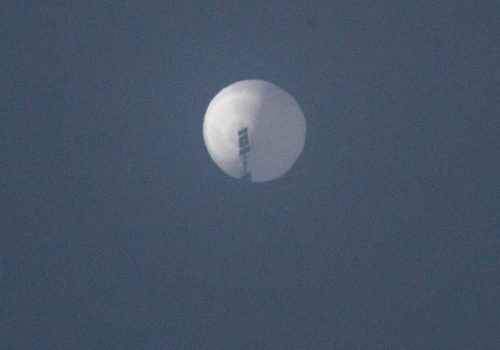This post was updated on April 10
It’s high-wire diplomacy. Taiwanese President Tsai Ing-wen traveled to New York, then to Guatemala and Belize before a final stop in Los Angeles last week for a highly anticipated meeting with US House Speaker Kevin McCarthy. The visit comes as tensions between the United States and China are nearing a boiling point, and as Taiwan is hustling to hang on to its allies in Latin America after Honduras recently switched to recognizing Beijing. Meanwhile, former Taiwanese President Ma Ying-jeou visited China—an exceedingly rare instance of high-level cross-strait diplomacy. China responded with military exercises near Taiwan. Below, our experts explore what’s next.
Monday, April 10
Matt Geraci: The reaction to Tsai’s congressional meetings suggests that Beijing does not want to escalate
Friday, April 7
Kitsch Liao: Assertive moves from Congress give a glimpse of China’s escalatory ladder
Monday, April 3
Markus Garlauskas: Don’t let Beijing define the narrative of Taiwan’s relations with the world
Friday, March 31
Leland Lazarus: Tsai will play up concrete reasons for Guatemala and Belize to remain allies
Thursday, March 30
Wen-Ti Sung: Military escalation would not redound to Beijing’s benefit
Lev Nachman: Even though Tsai’s US trip is typical, expect an exaggerated response from China
The reaction to Tsai’s congressional meetings suggests that Beijing does not want to escalate
An all-too common pattern of events unfolded following Tsai’s meeting with McCarthy and his supporting congressional delegation in California. Tsai’s transits through the United States as president of Taiwan, of which this is her seventh such visit, historically have drawn the ire of Beijing and often result in a mixture of diplomatic sanctions and military exercises. This past weekend was no exception. Following sanctions on the Hudson Institute and Ronald Reagan Presidential Library, China announced a three-day long Joint Sword exercise beginning on April 8, which simulated an air and sea blockade of Taiwan, as a “stern warning” to the Taiwanese and US governments. China sent more than seventy aircraft sorties near Taiwan on all three days of the drills, approaching past record single-day tallies for such flights since Taipei began releasing data on the flights in 2020.
The frequency of US congressional delegation visits and Tsai’s transits through the United States has steadily increased. But despite the narrative pushed by Beijing, there is nothing within the One China Policy (which is guided by the Taiwan Relations Act), the three US-China Joint Communiques, and the Six Assurances that forbids sitting members of Congress from engaging with members of the Taiwanese government, including its president. Rhetoric is not policy—the US approach to Taiwan has remained consistent no matter the rhetorical support provided by sitting members of Congress responding to threats made by Beijing to cease interactions with Taiwan’s government.
As a quick review, Beijing’s diplomatic and/or military responses to Tsai’s transits through the US have steadily ramped up in intensity over the years:
- Tsai’s first transit through the United States as Taiwan’s president in June and July 2016 led to a diplomatic response, in which China suspended diplomatic contact with Taiwan.
- Beijing reacted to her second transit through the United States in January 2017 by sailing its first aircraft carrier, the Liaoning, through the Taiwan Strait in the weeks prior to the visit.
- During her third transit through the United States in October and November 2017, Chinese bombers reportedly “test[ed] U.S. defense zones around Guam.” around this period.
- In the days leading up to her fourth transit through the US in August 2018, Chinese Foreign Ministry spokesman Geng Shuang urged the United States “not to allow the transit of the leader of the Taiwan region, and not send any wrong signals to Taiwan independence forces.”
- Following her fifth transit through the United States in March 2019, two PLA J-11 fighter jets crossed the median line for the first time since 1999, though this could have also been attributed to two US vessels, the USS Curtis Wilbur destroyer and Coast Guard cutter USCGC Bertholf, sailing through the Taiwan Strait around the same time.
- After her sixth transit through the United States in July 2019, the Cross-Strait Tourism Exchange Association announced the suspension of a pilot program that allowed Chinese citizens to visit Taiwan for leisure, and shortly after Tsai’s return, China held military exercises on both ends of the Taiwan Strait from July 28 to August 2. This was the first occurrence of simultaneous exercises since the Third Taiwan Strait Crisis of 1995–1996.
In comparison with reactions to her past transits, this appears to be a significant ramping up of Chinese actions. Yet, how Beijing chose not to respond was just as notable as how it did. In a surprise epilogue to the McCarthy-Tsai meeting in California, a delegation led by House Foreign Affairs Committee Chairman Michael McCaul arrived in Taiwan on April 6 before she had even returned from her US transit. During a luncheon with Tsai on April 8, McCaul pledged to “speed up” weapons sales to Taiwan.
The timing of McCaul’s delegation visit was likely aimed in part to occur after Beijing had already initiated a response to the McCarthy-Tsai meeting in California, catching China on the backfoot and testing the limits of how much further a subsequent reaction might go. As noted by Wall Street Journal China Bureau Chief Jonathan Cheng, McCaul’s visit with seven other lawmakers, which normally would have received strong backlash from Beijing, has largely been ignored by Chinese state media. Markus Garlauskas, director of the Atlantic Council’s Indo-Pacific Security Initiative, suggested on Twitter that the relative size of the exercise was notably contained compared to how large it could have been.
One might have expected the combination of Tsai’s meeting with McCarthy and the surprise delegation visit by McCaul in Taipei could have led to Beijing responding even more aggressively than it had in response to then House Speaker Nancy Pelosi’s historic visit to Taipei in August 2022, in which five days of People’s Liberation Army navy and air force exercises were initiated and test missile launches struck the waters east, northeast, and southeast of Taiwan. The fact that, as of this writing, no additional measures have been taken by Beijing indicates that there may be some desire not to escalate things further.
—Matt Geraci is an assistant director at the Atlantic Council’s Global China Hub.
Assertive moves from Congress give a glimpse of China’s escalatory ladder
Tsai’s meeting with McCarthy did not break new ground, as this would be the third time a Taiwanese president has met a US House speaker. But it holds greater significance when considered along with frequent US delegation visits to Taiwan and increasingly frequent administration and track-two conversations between the two governments on arms delivery, countering disinformation, and economic cooperation. The low-profile but more frequent interaction between the Biden administration and Taiwan is a smart move, especially before adequate guardrails and lines of communication can be established between the United States and China to prevent any inadvertent escalation.
One notable outcome of the discussion was McCarthy’s call for the United States to expedite delivery of arms to Taiwan to shore up its ability to defend itself. Over the past year, despite the urgent need for asymmetric and survivable weapon systems in line with Taiwan’s overall defense concept, about half of US arms sales to Taiwan (its only foreign source of arms) was made up of spare parts, munitions, and support on weapon systems already approved from previous sales, while the rest consists of legacy acquisitions. That’s because under foreign military sales programs, it takes years of lead time to clear bureaucratic processes. But this may be starting to change, as Defense Secretary Lloyd Austin recently stated that for Taiwan the Pentagon intends to use presidential drawdown authority, which allows the president to bypass normal procedural requirements and draw from existing US stocks immediately to reinforce Taiwan’s needs.
The strong show of support for Taiwan from both McCarthy and House Foreign Affairs Committee Chairman Michael McCaul—who made a surprise visit to Taiwan on Thursday—sends a message to China on Congress’ willingness to represent the United States in a more assertive manner and compel China to demonstrate its own red lines and guardrails. China has traditionally kept vague its own red lines and eschewed any direct line of communication in crisis situations. That is designed for a relatively risk-averse opponent to back down.
Both leaders, however, also reiterated strong support for the US-Taiwan and US-China policies of Three Communiques, Six Assurances, and Strategic Ambiguity (Dual Deterrence), which together have been in place since the 1970s. This is a deliberate move to assure China that there has been no policy change toward Taiwan and offer China an off-ramp in an escalatory situation. The delicate balance between providing sufficient military deterrence to make a Chinese invasion difficult, while also providing sufficient political assurances so that the Chinese Communist Party government can credibly assuage its internal political rivals that the possibility of an eventual unification is not entirely lost, is one that is well understood by both the US and Taiwan governments.
Now the United States should closely observe China’s rhetorical, kinetic, and domestic censorship responses to discern a coherent picture of China’s escalatory ladder. Such a determination is crucial to formulating a more precise and hopefully peaceful solution to a seven-decade-old dilemma.
One initial and perhaps alarming example of Chinese kinetic response took place shortly before Tsai-McCarthy meeting. The Chinese Coast Guard announced an inspection exercise for all civilian traffic in the “three small links (小三通)” routes between China and Taiwan, a move that evokes a potential quarantine or blockade. In 2019 the coast guard was moved under the People’s Armed Police, a paramilitary force that is neither part of the People’s Liberation Army nor entirely a law enforcement organization, but is one with a heavy emphasis on domestic stability. Its role offers a hint of how China might choke off the Taiwan Strait.
—Kitsch Liao is an assistant director at the Atlantic Council’s Global China Hub.
Tsai’s visit to Central America glosses over a powerful pillar of Taiwanese diplomacy: free trade
Over the weekend, Tsai concluded a three-day trip to Guatemala and began her tour of Belize. As two of Taiwan’s thirteen remaining allies following Honduras’ switch to Beijing on March 25, both countries have taken on even greater visibility and strategic importance. Tsai’s itinerary highlights the results of Taiwanese infrastructure and capacity-building investments, while underscoring the promise of multilateral collaboration that often accompanies Taiwanese projects.
But surprisingly, Tsai’s diplomatic tour has left a key strength of Taiwanese diplomacy in Central America largely unsaid: Taiwan’s commitment to free trade with its allies. Since 2006, Guatemala has maintained a free trade agreement (FTA) with Taiwan, while Belize and Taiwan’s economic cooperation agreement came into force in 2022. When Panama, Nicaragua, and Honduras were Taiwanese allies, Taiwan similarly signed FTAs with all. The Panama-Taiwan FTA was withdrawn in 2017, while the Nicaragua-Taiwan FTA was reversed in 2021 after those countries severed relations. Yet even after Honduras’ switch last month, Taiwanese authorities have recently claimed that the Honduras-Taiwan FTA remains in effect. Meanwhile, of all the former Taiwanese allies that China has built diplomatic ties with since the early 2000s, the only country China has signed an FTA with is Costa Rica.
Taiwan’s commitment to free trade is a unique and underplayed asset in its foreign policy arsenal that, if leveraged strategically, could further highlight the democratic island’s global profile. As recent events illustrate, free trade with Taiwan did not prevent Honduras from accumulating $600 million in debt to Taiwan, nor is free trade a universal salve to the challenges that Taiwan’s allies face. Yet in a Latin American macroeconomic environment concerned with growing trade deficits or the potential for Chinese “debt trap diplomacy,” Taiwan and its remaining partners could offer an alternative vision for economic cooperation. Tsai would be well-suited in trips like these to make the case for free trade.
—Isabel Bernhard is an assistant director at the Atlantic Council’s Adrienne Arsht Latin America Center.
Don’t let Beijing define the narrative of Taiwan’s relations with the world
China is yet again ramping up its saber-rattling over the travels of Taiwanese President Tsai Ing-wen, who is sandwiching stops in New York and Los Angeles around her ongoing trip to Central America. But that should not deter US leaders—including Speaker of the House Kevin McCarthy, who plans to meet with Tsai this week in Los Angeles—from staying the course and engaging with Taiwanese officials.
Unfortunately, the media coverage of her US stopovers is not helping, as it has been dominated by the rhetoric and dire threats emanating from Beijing. Just a quick sampling of top headlines about Tsai’s travels shows how prominent this theme has been in the Western media:
- Beijing warns of ‘severe impact’ on US-China relations as Taiwan’s leader lands in New York
- China threatens retaliation if Kevin McCarthy meets with Taiwan’s president
- Taiwan’s President Lands in the U.S. Amid Threats From China
At first glance, with this sort of framing, it is easy to see how this situation could be misinterpreted. To those who do not track US-Taiwan relations closely, Tsai’s transit of the United States may seem to be a rare activity, a high-stakes display of diplomatic brinksmanship amid heightened tensions, or even an intentional poke in the eye to Chinese Communist Party leader Xi Jinping.
This framing serves Beijing’s interest in seeking to isolate Taiwan and portray both Taipei and Washington as provocateurs. The truth is, as US State Department officials have repeatedly stated, such transits are not unusual. This is the seventh time for Tsai herself.
To be clear, the United States and its friends around the world should not ignore threats from Beijing, implicit or explicit. Responsible leaders should not be complacent about the threat that the People’s Republic of China (PRC) poses to the international order as a strategic competitor and as a potential military aggressor. They should have no illusions about Xi’s willingness to use coercion and force to achieve his goals and to change the status quo. Listening, watching, and carefully assessing Xi’s “red lines” is also an important endeavor that may help to prevent a miscalculation that could lead to the most devastating war in human history. However, no country in the world should allow the near-constant stream of threats and warnings emitting from Beijing to lead it to believe that actions that are reasonable, routine, and restrained are instead risky, worrisome, and escalatory.
Read more from Markus Garlauskas, the director of the Indo-Pacific Security Initiative in the Scowcroft Center for Strategy and Security and a former senior US government official:
Tsai will play up concrete reasons for Guatemala and Belize to remain allies
Tsai arrives in Guatemala in the midst of a contentious presidential election season. Twenty-three candidates will vie for the presidency, and there are already concerns about ensuring a free and fair electoral process ahead of the June 25 election. Taiwan hasn’t been a topic of contention among presidential candidates, but it’s possible that some candidates may criticize Tsai for meeting with the deeply unpopular President Alejandro Giammattei, unless she also meets with opposition figures.
During her trip, Tsai will most likely visit various projects funded by Taiwan’s International Cooperation and Development Fund (ICDF), including health care personnel training programs, agribusiness technical assistance, and financial support to local entrepreneurs. Last year, Taiwan also paid for a lobbying contract to promote Guatemala with US officials, an odd example of the extent Taiwan will go to keep Guatemala as an ally. But whether this support is enough to prevent Guatemalan leaders from eventually making the same economic calculus as Honduras is yet to be seen. In December, Guatemala’s ambassador to Taiwan pledged that his country would plan a summit of “Taiwan-friendly” countries in March; as Tsai touches down in Guatemala, that pledge has yet to materialize.
In Belize, Tsai needs to demonstrate to local leaders that Taiwan continues to deliver on key local priorities, such as infrastructure, medicine and public health, and agricultural technology. In May 2022, Belize, Taiwan and the Inter-American Development Bank signed an agreement to support Belizean micro, small, and medium-sized enterprises, especially for women entrepreneurs. Taiwan’s ICDF provided five million dollars to this initiative. Tsai will likely visit local entrepreneurs who have benefited from this program. Tsai and her Belizean counterpart, Prime Minister John Briceño, might also announce new trade agreements for Taiwan to import Belizean citrus fruits, juice concentrate, and marine products such as shrimp, and for Belize to import Taiwanese electric buses to support Belize’s renewable energy goals.
—Leland Lazarus is a nonresident fellow at the Global China Hub and associate director for national security at Florida International University’s Jack Gordon Institute of Public Policy. He formerly served as special assistant and speechwriter to the commander of US Southern Command and as a US State Department foreign service officer in China and the Caribbean.
Military escalation would not redound to Beijing’s benefit
China will register its displeasure with Tsai’s US trip. Rhetorical censure, check. Targeted sanctions including blacklisting of select Taiwanese politicians and entities, possible. Some limited economic sanctions and military show of force, also in the cards.
But it would not be in Beijing’s strategic interest to use egregiously escalatory military action in retaliation, given two considerations: third-party audiences and the trip by Taiwan’s ex-President Ma to China.
First, third-party audiences such as Europe would rather not see the Taiwan Strait situation escalate, for they are already busy with Ukraine and post-COVID economic recovery. And they understand Taiwan and the United States get this and are therefore opting to hold Tsai’s meeting with McCarthy on US soil, a less politically sensitive option to Beijing than McCarthy visiting Taiwan.
In other words, Taiwan and the United States are already choosing the relatively less provocative option. If in response, Beijing still chooses to retaliate at a level matching or even exceeding what it did after then Speaker Nancy Pelosi’s Taiwan visit in August 2022, then the United States and Taiwan will cite Beijing’s reaction to seize the high ground in the eyes of other governments and paint a picture of an insatiable Beijing that no one can work with.
Second, Ma’s trip marks the first visit to China by a former or sitting Taiwanese president in more than half a century. If Beijing escalates militarily, it will waste this rare opportunity to underscore cross-strait friendship, in exchange for chipping away at the success of Tsai’s US trip ever so slightly.
So if Beijing does escalate militarily, despite all these downsides, it would either be a sign of questionable strategic thinking or misalignment among internal agencies working at cross purposes. China is not always playing three-dimensional chess.
—Wen-Ti Sung is a nonresident fellow at the Atlantic Council’s Global China Hub and a political scientist at the Australian National University’s Taiwan Studies Program.
Even though Tsai’s US trip is typical, expect an exaggerated response from China
On paper, it is totally normal and in accordance with US protocol for a Taiwanese president to stop over in the United States. Every Taiwanese president, regardless of whether they are from the Democratic Progressive Party (DPP) or the Kuomintang (KMT), has made these types of trips in the past. Even former president Ma—who is currently on his own semi-diplomatic trip to China—made no small number of visits to the United States while he was president. Tsai herself last visited in 2019 to give a speech at Columbia University, during which the People’s Republic of China’s (PRC) response was largely muted.
But an action like a Taiwanese president flying through the United States, which in the past was seen as a normal, small, and inconsequential act, is now going to be portrayed by the PRC as large, antagonistic, and escalatory. Even though Taiwanese presidential visits have been a longstanding practice, in the year 2023 when US-China-Taiwan tensions have reached an all-time high, such acts have become far more politicized, despite previous practices or intentions.
Regardless of precedent, we should still anticipate an exaggerated response from the PRC. One silver lining, however, is that Tsai’s stopover in the United States is unlikely to result in large-scale military drills from the PRC similar to those that followed Pelosi’s visit to Taiwan in August 2022. Tsai’s move to meet McCarthy in the United States instead of having him come to Taiwan was a smart, pragmatic move by Tsai that helps ensure that we do not see a repeat of August 2022. Even though the PRC will make an unnecessarily big deal out of Tsai’s trip, from the PRC’s perspective it is far less inflammatory than McCarthy going to Taiwan. But we should still expect some kind of overstated response from China, likely in the form of fighter jets flying over the Taiwan Strait Median Line and combative rhetoric from the PRC leadership.
—Lev Nachman is a nonresident fellow in the Atlantic Council’s Global China Hub and an assistant professor at National Chengchi University in Taipei, Taiwan.
Further reading
Wed, Mar 15, 2023
Experts react: Honduras is establishing ties with China. What should Taiwan and the US do?
Experts react By
With the switch, Taiwan will only be formally recognized by thirteen countries. Our experts weigh in on what it means for Honduras, China, and the United States.
Fri, Jan 13, 2023
The 2023 Global Energy Agenda
Global Energy Agenda By
The third edition of the Global Energy Agenda provides context for the year that has passed. It features a survey of thought leaders in the energy sector, as well as a series of essays by the leading figures in energy, to set the energy agenda for 2023.
Fri, Feb 3, 2023
Five questions (and expert answers) about the curious case of the Chinese spy balloon
New Atlanticist By
US fighter jets have shot down a suspected Chinese spy balloon, but the tensions linger in the world's most important bilateral relationship. Our experts float their takes.
Image: Taiwanese President Tsai Ing-wen waves to the media before her departure to New York to start her trip to Guatemala and Belize at Taoyuan International Airport in Taoyuan, Taiwan March 29, 2023. REUTERS/Ann Wang
